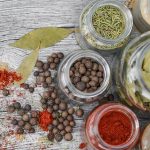Aller-Lung Support™ for Perennial or Seasonal Allergies
Imagine just one supplement that contains foods that have been shown to help with perennial and/or seasonal allergy symptoms:
- sneezing
- congestion
- phlegm accumulation
- runny nose
- red eyes
- teary eyes
- watery eyes
- histamine release
The immune system is quite complex, but when it reacts to normally harmless foods and pollens allergies, sinus complaints, and/or asthma can result (although there are many possible causes of asthma). Of course, not all airborne substances are harmless, as tobacco smoke, fires, and environmental pollutants also seem to contribute to allergies and asthma [1]. And all of these problems can cause or worsen sinus, lung, and bronchial congestion. Throughout the past couple of centuries, many Foods have been consumed to help reduce the histamine-type reactions that allergies tend to produce.
Acerola Cherry is one of the most vitamin C dense Foods [2]. Not only does it have free radical scavenging abilities, it also has been shown to increase the antioxidant abilities of some other foods [3]. “Acerola”contains bioflavonoids” [3], anthocynins, and quercitin [4]. One study concluded that vitamin C “supplementation provides a protective effect against exercise-induced airway narrowing in asthmatic subjects” [5].
- Bioflavonoids, such as Quercitin dihydrate have long been used for allergies. Even the PDR admits that quercetin may “have benefit in some allergic conditions, in conditions characterized by capillary fragility, in chronic prostates and in some cancers”Quercetin is one of several flavonoids that have effects on mast cells and basophils”it might be useful in some allergies, such as hay fever. Quercetin can help prevent the release of histamine and other mediators of allergies, possibly stabilize cell membranes so that they are less reactive to allergens” [2]. “The major active biological constituents in Citrus herbs are flavonoids, especially hesperidin, naringin and alkaloids, mainly synephrine, with beneficial medical effects on human health” [6]. Quercetin is often advised for those with asthma, allergic rhinitis, or hay fever [7]. Bioflavonoids are also sometimes simply called flavonoids. Citrus bioflavonoids have been found to have anti-allergic effects and may be useful to improve symptoms associated with seasonal allergic rhinitis [8].
Bromelain fruit Ananas comosus is a widely used pineapple extract. And while it is most commonly used for inflammation, it has been used for “asthmatic conditions” [9-10]. Furthermore, the PDR reports, “Bromelains reported mucolytic activity has prompted some use of it in respiratory tract diseases. It has been shown to be of benefit in chronic bronchitis and, in a double-blind study, acute sinusitis”In the realm of immunity, bromelain is being tested for possible effects in T cell-mediated autoimmune diseases”In combination with tyrpsin and the flavonoids rutin, bromelain has been reported to protect against experimental allergic encephalitis” [2].
- Fenugreek Trigonella foenum-graecum has been used for “upper respiratory catarrah” [9]. It is “often used for breathing” [11]. It is a common ingredient in curries. It has been advised for allergies, asthma, bronchial conditions, emphysema, lung infections, and sinus conditions [12]. “Fenugreek has been shown to soften and dissolve hardened masses of accumulated mucous”It loosens and expels mucus and phlegm accumulated in the bronchial tubes ” [12].
- Fructus aurantia immaturi is also known as immature bitter orange. “The predominant adrenergic protoalkaloid found in the peel and fruit of bitter orange, Citrus aurantium, is synephrine” [13], m-synephrine. M- synephrine (phenylephrine) promotes normal nighttime breathing by relieving congestion and phlegm in nasal passages, helps inhibit histamine production, and sometimes is used in anti-snoring products. A pharmaceutical form of synephrine is used in allergy/hay fever medications like Neo-Synephrine [14].
- Stinging Nettle Urtica dioica “Nettle can alleviate allergic symptoms such as teary eyes and a runny nose” [12]. It is sometimes used those with asthma, bronchitis, or catarrhal conditions [12]. Nettles are “[g]ood for hay fever and other allergic disorders”and mucous conditions of the lungs” [7]. It is sometimes advised to help “ward off severe allergic reactions” [7]. A double-blind study found nettles to be more effective than a placebo for people with allergic rhinitis [15].
Thyme Thymus vulgaris has been approved for use by the European Commission E for cough and bronchitis [9]. The PDR states, “The herb is used internally for catarrh of the upper respiratory tract, dyspeptic complaints, asthma, laryngitis, chronic gastritis, and whopping cough” [9]. One study reported, “It is well known that nitric oxide (NO) plays an important role in the pathogenesis of inflammatory diseases. . Thymus vulgaris L. have been used in traditional medicine in the treatment of bronchitis, asthma and other respiratory diseases. The present study focuses on the effects of these” extracts on NO production induced by lipopolysaccharide (LPS) and interferon-gamma (IFN-gamma) in the murine macrophage cell line J774A.1. In addition, cell viability, scavenging activity and inducible nitric oxide synthase (iNOS) mRNA expression were evaluated”T. vulgaris extracts significantly inhibited the enhanced production of NO induced by LPS and IFN-gamma in a dose-dependent manner. Treatment with these “extracts did not reduce cell viability at any dose used” plant extracts showed significant scavenging of NO radicals released by an NO donor, PAPA-NONOate. Results also show that pre-treatment with”T. vulgaris extracts significantly inhibits iNOS mRNA expression. This study thus suggests that the inhibition of net NO production by these”extracts may be due to their NO scavenging activity and/or their inhibitory effects on iNOS gene expression” [16].
Note: People with allergies can be allergic to many things, including herbs used with allergies. Also, if one has some type of Staphylococci infection, it is normally best to avoid bovine (cow) dairy and sometimes oat-containing products.
The 100% Food Aller-Lung Support formula contains herbs that can help support the lungs and sinuses. For people with year-round or seasonal allergies, naturally-inclined doctors advise Food Aller-Lung Support.
Note: People with allergies can be allergic to many things, including herbs used with allergies. Also, if one has some type of Staphylococci infection, it is normally best to avoid bovine (cow) dairy and sometimes oat-containing products.
The 100% Food Aller-Lung Support formula contains herbs that can help support the lungs and sinuses. For people with year-round or seasonal allergies, naturally-inclined doctors advise Food Aller-Lung Support.
When shopping for food supplements look for wild-crafted, organic foods with no rocks or minerals in your food - humans don't eat rocks. Read more about Food Research Supplements here
Have questions call us at 310-200-2127 for an appointment or simply order by clicking SHOP below.
References
[1] Tecer LH, Alagha O, Karaca F, Tuncel G, Eldes N. Particulate Matter (PM(2.5), PM(10-2.5), and PM(10)) and Children’s Hospital Admissions for Asthma and Respiratory Diseases: A Bidirectional Case-Crossover Study. J Toxicol Environ Health A. 2008;71(8):512-20
[2] Sheldon SH, Rorvik D, eds. PDR for Nutritional Supplements. Medical Economics, Montvale (NJ), 2001
[3] Hwang J, Hodis HN, Sevanian A. Soy and alfalfa phytoestrogen extracts become potent low-density lipoprotein antioxidants in the presence of acerola cherry extract. J Agric Food Chem. 2001;49(1):308-314
[4] Hanamura T, Mayama C, Aoki H, Hirayama Y, Shimizu M. Antihyperglycemic effect of polyphenols from Acerola (Malpighia emarginata DC.) fruit. Biosci Biotechnol Biochem. 2006 Aug;70(8):1813-20
[5] Tecklenburg SL, Mickleborough TD, Fly AD, Bai Y, Stager JM. Ascorbic acid supplementation attenuates exercise-induced bronchoconstriction in patients with asthma. Respir Med. 2007 Aug;101(8):1770-8
[6] Ding L, Luo X, Tang F, Yuan J, Liu Q, Yao S. Simultaneous determination of flavonoid and alkaloid compounds in Citrus herbs by high-performance liquid chromatography-photodiode array detection-electrospray mass spectrometry. J Chromatogr B Analyt Technol Biomed Life Sci. 2007 Oct 1;857(2):202-9
[7] Balch JF, Balch PA. Prescription for Nutritional Healing. Avery Publishing, Garden City (NY), 1997
[8] Tanabe S, Kinuta Y, Yasumatsu H, Takayanagi M, Kobayashi S, Takido N, Sugiyama M. Effects of Citrus unshiu Powder on the Cytokine Balance in Peripheral Blood Mononuclear Cells of Patients with Seasonal Allergic Rhinitis to Pollen. Biosci. Biotechnol. Biochem. 2207, 71 (11), 2852″2855
[9] Gruenwald J, Brendler T, Jaenicke C, editors. PDR for Herbal Medicines, 4th ed. Thomson, Montvale (NJ), 2007
[10] Secor ER, Carson WF, Singh A, Pensa M, Guernsey LA, Schramm CM, Thrall RS. Oral Bromelain Attenuates Inflammation in an Ovalbumin-induced Murine Model of Asthma. Evid Based Complement Alternat Med. 2008 Mar;5(1):61-9
[11] Profiles in Nutritional Progress. Rubicon Productions, Bakersfield, 1993
[13] Nelson BC, Putzbach K, Sharpless KE, Sander LC. Mass spectrometric determination of the predominant adrenergic protoalkaloids in bitter orange (Citrus aurantium). J Agric Food Chem. 2007 Nov 28;55(24):9769-75
[15] Mittman P. Randomized, double-blind study of freeze-dried Urtica dioica in the treatment of allergic rhinitis. Planta Med. 1990 Feb;56(1):44-7
Some of these studies (or citations) may not conform to peer review standards. Therefore, the results are not conclusive. Professionals can, and often do, come to different conclusions when reviewing scientific data. None of these statements have been reviewed by the FDA.
* All products distributed by Doctors” Research, Inc. are nutritional and are not intended for the treatment or prevention of any medical condition
Subscribe below so you don't miss out on my newsletter or discounts - your email will never be scammed or sold.




